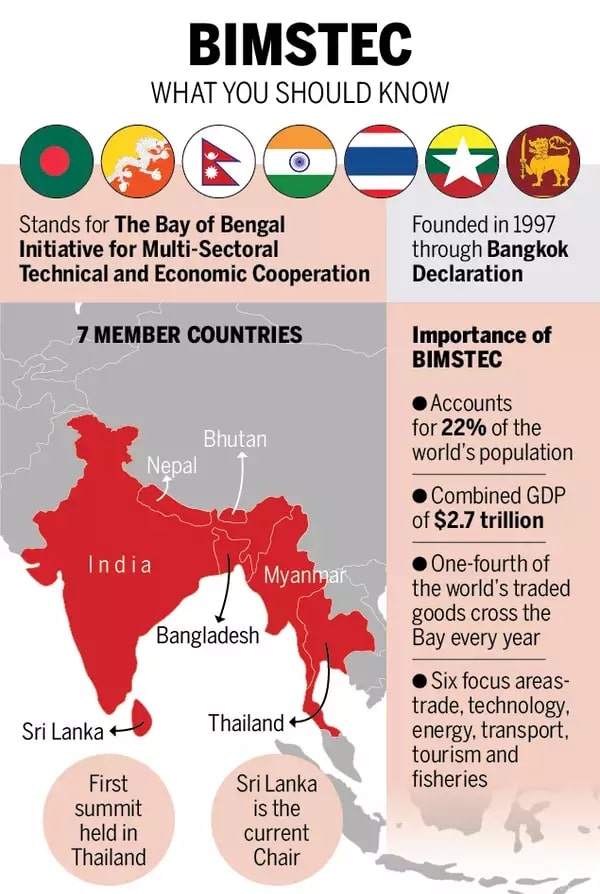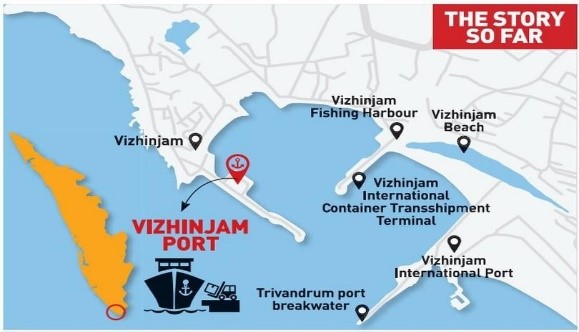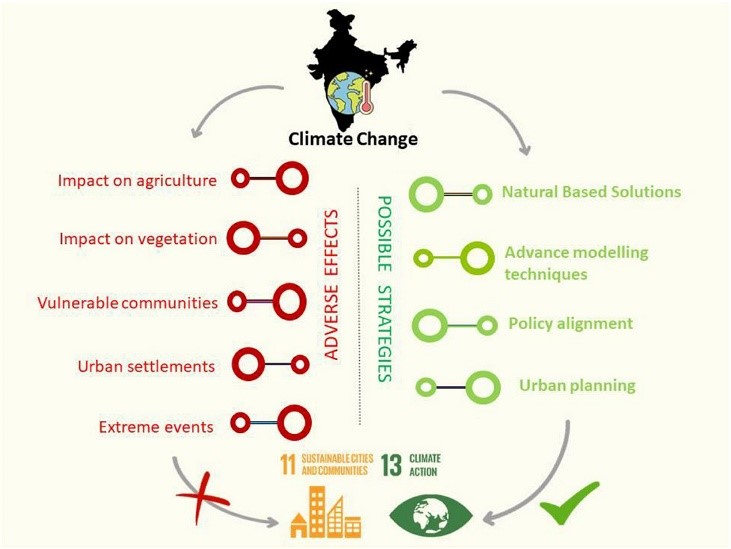- Home
- Prelims
- Mains
- Current Affairs
- Study Materials
- Test Series
July 12, 2024 Current Affairs
India hosts BIMSTEC Foreign Ministers amid raging Myanmar crisis
BIMSTEC
- The BIMSTEC is a regional organisation comprising seven Member States:five deriving from South Asia, including Bangladesh, Bhutan, India, Nepal, Sri Lanka and two from Southeast Asia, including Myanmar and Thailand.
- This sub-regional organisation came into being on 6th June 1997 through the Bangkok Declaration.
- The BIMSTEC Secretariat is in Dhaka, Bangladesh.
Principles of BIMSTEC
- Sovereign Equality
- Territorial Integrity
- Political Independence
- No-interference in Internal Affairs
- Peaceful Co- existence
- Mutual Benefit
- Constitute an addition to and not be a substitute for bilateral, regional or multilateral cooperation involving the Member States.

Myanmar crisis:
The Myanmar crisis refers to the political turmoil and military coup in Myanmar since February 2021, impacting regional stability, international relations, and humanitarian issues.
- Top of Form
- Bottom of Form
HIGHLIGHTS:
- External Affairs Minister S Jaishankar host his counterparts from the BIMSTEC member countries at a two-day retreat beginning Thursday 11 July in the national capital.
2. The retreat will present an opportunity for the foreign ministers to discuss avenues to deepen cooperation across various sectors including in the fields of security, connectivity and trade, the Ministry of External Affairs (MEA) said.
3. Myanmar’s Deputy Prime Minister U Than Swe is also joining it.
Centre begins efforts to implement Labour Codes
LABOUR CODES
- In an effort to codify the numerous labour laws in the nation, the Parliament recently passed three labour codes on industrial relations, social security, occupational safety, health, and working conditions, along with the wage code passed in 2019. The four Codes are part of the government’s labour law reforms agenda.
- The streamlining of labour laws has been a work in progress, with the Centre notifying four broad labour codes to replace 29 sets of labour laws:
- The Code on Wages, 2019;
- The Industrial Relations Code, 2020;
- The Code on Social Security, 2020; and
- The Occupational Safety, Health and Working Conditions Code, 2020.
The objective is to encompass over 500 million organized and unorganized sector workers—90% of the workforce which has been outside labour laws.
The Benefits of Labour Codes
- Simplification of the Complex laws:The Labour Codes simplify labour laws by consolidating 29 central laws that have been on the table for at least 17 years.
- It will provide a big boost to industry & employment and will reduce multiplicity of definition and authority for businesses.
- Easier Dispute Resolution:The codes simplify archaic labour laws and revamp adjudication processes, which will lead to quicker dispute resolution.
- Ease of Doing Business:Several economists and industry experts say these reforms will boost investment and make doing business easier.
- They predict that these reforms will reduce internal contradictions, increase flexibility, and modernise safety and working conditions regulations.
- Gender Parity:All sectors must allow women to work at night, but employers must ensure that security arrangements are made for them, and women must consent before working at night.
Concerns
Implementation:
- It was deliberated whether it should be implemented phase-wise.
- A part of the discussion was that the Wage Code and the Social Security Code could be brought in first, but then it was felt that if the remaining two are not brought in simultaneously, their turn may not come.
- It has to be wholesome, for both workers and the industry
Impact take-home pay:
- A key change in the definition of “wage” would impact take-home pay, but increase retirement savings, something that a section of employers is opposed to as it may increase their employee costs.
The burden on firms & companies:
- Firms will have to bear a higher provident fund liability.
- Companies would also need to adjust their payroll operations if the wage code were to become law, working around the deadlines and methods for determining the full settlement of salaries within two working days.
Strikes may become harder:
- Due to these new changes, industrial strikes may become harder which is a negative impact on the workers.
Political challenge:
- Early-2023 is being considered a feasible option for rolling out these codes.
- But the fact is that it cuts too close to the 2024 general elections.
- The current government might show hesitation in taking this step as these are expected to introduce sweeping changes that would affect both businesses and workers.
Conclusion
- While industries are entitled to make a reasonable profit on investment, workers are equally entitled to reasonable wages and good and safe working conditions.
- It is an uphill task to enact and codify rules that satisfy both parties and the mid path, taking care of the interest of both should be the goal of any labour legislation. To that end, the four labour codes have been rightly grouped together.
- While the labour codes could be called “historic” because they come after nearly a century, the exuberance of the Union govt terming them as “landmark” and “game-changer” is an exaggeration.
- The laws have adapted to the prevailing industrial and economic activity, but there is a long way to go to achieve a fine balance in the interest of workers and the industry.
- The government needs to work more to recognise that focusing on economic growth without redistribution of wealth leads to jobless growth and socially unaccountable prosperity.
- Every law has to aim to maintain the best possible balance between competing interests and should try to give as much comfort to the weaker of the two sides, as much possible in the larger interest of our nation.
- Ultimately these laws will be as good as their implementation, mere letters of law have no meaning.
Vizhinjam port welcomes 1st mothership
Vizhinjam International Seaport:
- It is India’s first deep-water container transshipment port.
- Location: It is located at Vizhinjam, a coastal town in ThiruvananthapuramDistrict,
- It is located around 10 nautical miles from the international shipping route connecting Europeand the Persian Gulf with East Asia, through which around 30 percent of global maritime cargo passes.
- It is developed in a landlord model with a public-private partnership component on a design, build, finance, operate, and transfer (“DBFOT”) basis.
- It is being built by Adani Vizhinjam Ports Private Ltd., a subsidiary of Adani Ports and SEZ Ltd. (APSEZ), India’s largest private sector port operator.
- Construction of the port began in December 2015.
- It is being designed to primarily cater to the transshipment and gateway container business, with provision for a cruise terminal, liquid bulk berth, and facilities for additional terminals.
- It has a natural draft of 18-20 meters, which means that some of the largest container vesselsin the world will be able to dock here.
- There would be about 30 berths, most of which would be capable of handling mother vessels.

Significance of the port
- The port is the only transshipment hub in the Indian subcontinent, strategically located close to international shipping routes and centrally on the Indian coastline. Around 95% of India’s foreign trade is conducted via the sea route, accounting for 70% of the trade in value terms.
- Nearly 30% of freight movement occurs through the international shipping route south of the Indian peninsula, passing just 10 NM off Vizhinjam.
Mothership Also known as San fernando
- ''San Fernando'', a vessel of the world''s second-largest shipping company Maersk, arrived at the port country with over 2,000 containers on it, thus creating history.
- The giant vessel was given the traditional water salute following which it berthed successfully.
- With the arrival of the first mother ship, Adani Group''s Vizhinjam Port has catapulted India into the world port business as globally this port will rank 6th or 7th.
Zika virus: the need to improve surveillance and vector control
What is Zika Virus?
- The Zika virus, a mosquito borne flavivirus, that is primarily spread by Aedes mosquitoes, particularly Aedes aegypti.
- Also, it can also be transmitted from mother to fetus during pregnancy, as well as through sexual contact, transfusion of blood and blood products.
- The Zika virus has an RNA Genome, and thus a very high potential to accumulate mutations.
- Genomic studies have suggested that the Zika virus has two lineages: African and Asian.
Symptoms:
- Often asymptomatic; when present, common symptoms include fever, joint pain, muscle pain, and headache lasting 2-7 days.
Association with Other Conditions:
- Linked with Guillain-Barre syndrome, neuropathy, and myelitis in adults and children.
- Also, the interaction between Zika and dengue viruses significantly impacts disease severity.
- Exposure to one can worsen the impact of the other, posing challenges in vaccine development and public health management.
India’s Lack of Significant Zika Surveillance and Other Diseases
- Limited Diagnostic Capabilities: India faces challenges with the absence of approved diagnostic tests for the Zika virus, relying on clinical symptoms and selective testing, which may lead to underreporting.
- Surveillance Gaps: There is a notable gap in systematic surveillance systems specifically tailored for Zika and other emerging infectious diseases, hampering early detection and containment efforts.
- Infrastructure Deficiencies: The country’s diagnostic infrastructure outside major institutes is inadequate, affecting the timely identification and response to outbreaks of diseases like Zika, Nipah, and avian influenza.
- Dependency on Apex Institutes: Diagnostic facilities are largely concentrated in apex national institutes, limiting accessibility and delaying the implementation of crucial public health measures during outbreaks.
Initiatives of Government of India to control the spread of Zika Virus
- National Guidelines for Zika Virus Disease under Integrated Disease Surveillance Programme.
- Rashtriya Bal Swasthya Karyakram (RBSK): It aims to improve the quality of life of children and provide comprehensive care to all children in the community.
- RBSK involves screening of children from birth to 18 years of age for four Ds:
- Defects at birth
- Deficiencies
- Diseases
- Development delays including disability
Climate Skills Seeds for Transition India
The British Council, in partnership with HSBC India launched the ‘Climate Skills: Seeds for Transition India’ project that aims to equip youngsters with knowledge and skills on climate change and its challenges. The project seeks to engage 2,000 youngsters and 300 master trainers, and is expected to run from July this year to February 2026. Internationally, the project works with 18 to 30-year-olds in five countries — India, Brazil, Indonesia, Mexico, and Vietnam.
Climate Change:
The periodic modification of Earth’s climate brought about due to the changes in the atmosphere as well as the interactions between the atmosphere and various other geological, chemical, biological and geographical factors within the Earth’s system is called Climate change.
Factors Contributing to Climate Change:
Greenhouse Gas Emissions:
- Burning fossil fuels (coal, oil, and natural gas) releases carbon dioxide (CO2) into the atmosphere.
- Industrial activities, transportation, and deforestation contribute to GHG emissions.
Deforestation:
- Clearing forests reduces the Earth''s capacity to absorb CO2 through photosynthesis, contributing to increased atmospheric concentrations.
Industrialization and Urbanization:
- Rapid industrial growth and urbanization lead to increased energy consumption and emissions.
- Urban heat island effect exacerbates local warming in cities.
Impact of climate change










 Latest News
Latest News
 General Studies
General Studies